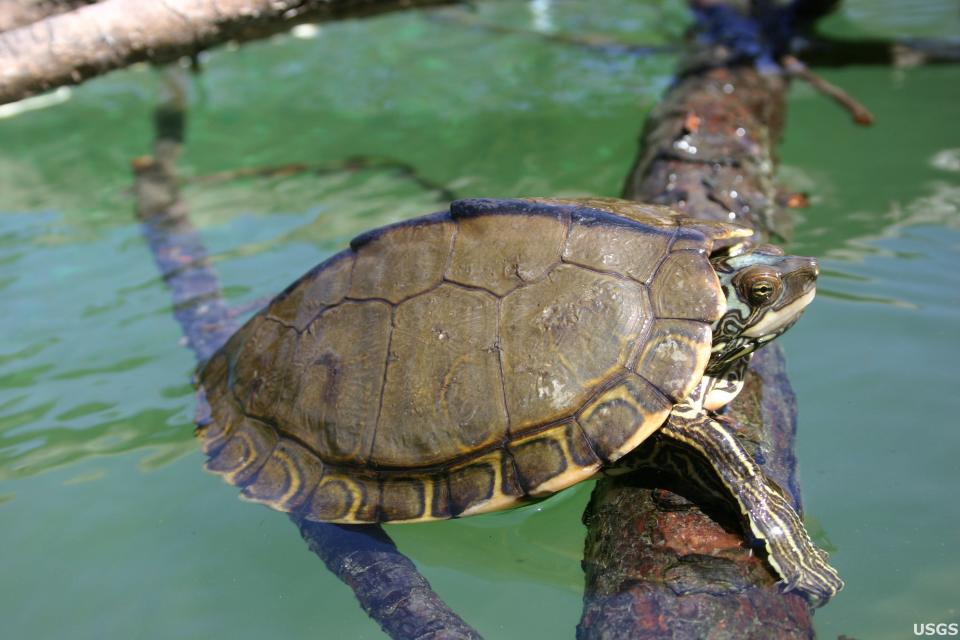Pearl River Map Turtles could delay One Lake project. What exactly are these turtles?
A potential new setback to the contentious One Lake development project comes down to the Pearl River Map Turtle, a species named for its distinct map-like shell pattern, that is unique to the Pearl River.
The Pearl River Map Turtle was discovered by researchers at the University of Southern Mississippi in 2010 and was officially inducted into the “endangered species” category by the U.S. Fish and Wildlife Service in a ruling Tuesday, July 9.
While the Army Corps of Engineers could still move forward with the controversial dam project that would cut through the Pearl River, it would have to consult the U.S. Fish and Wildlife Service about potential harms to endangered species, including the map turtle before starting construction.

At the University of Southern Mississippi back in 2010, graduate student researchers discovered the turtle by chance. Will Selman, now an associate professor of biology at Millsaps College, was collecting blood samples for several turtle species in the Pearl and Pascagoula rivers for his graduate dissertation. Noticing that his fellow graduate student, Joshua Ennen, was working on genetics, Selman passed the blood samples along.
“He found that the populations of what we thought were grafts out of the Pascagoula Map Turtle, were actually very distinct genetically between the Pearl and the Pascagoula river system,” Selman said.
Pearl River Map Turtles Endangered: Could Jackson One Lake flood control project be delayed due to ... turtles?
The two drainage systems have been separated by rising sea levels for a long time. That separation created genetic differences that in turn, resulted in two distinct species.
Until the genetic testing done in 2010, researchers assumed the populations in the Pascagoula and Pearl Rivers were one and the same.
Selman often explains the phenomenon to his students, through an analogy. The story of the two map turtles is like a squirrel population getting divided by the Grand Canyon. Over time, the populations grow separately from one another and adapt to their different environments, becoming separate populations with the canyon blocking their ability to intermingle.
More on endangered species in MS: Endangered fish reintroduced in Mississippi | Photos
Physically, the Pascagoula and Pearl map turtles look quite similar with only minute differences in their shell patterns and colors.
“But their genetics were very different,” Selman said. “We had both genetic markers and physical markers of the animals to say, ‘OK, these are two very distinct populations.’”
Most Pearl River map turtles spend their entire lives within 2 or 3 river miles and can only survive in freshwater.
“They're very much attached to a home range and understanding what is home and what is not home,” Selman said.
Though the new endangered species designation protects the Pearl River Map Turtle from hunting and poaching, it does not protect its habitat.
Over the past 15 years, there have been plenty of lawsuits in other endangered-species cases where U.S. Fish and Wildlife Services protected a species but not its environment. The Pearl River Map Turtle’s case will likely be no different and a lawsuit is imminent, Selman said.
More on One Lake: Jackson residents, environmentalists raise concerns about One Lake project alternatives
If the Army Corps of Engineers moves forward with a dam proposal, biologists worry that the Pearl River Map Turtle population would suffer. Short-term, the turtle’s food source, mainly freshwater mussels, would be destroyed because of sensitivity to water changes.
The dam would slow the normally fast-moving river water and disrupt the sediment normally suspended there, destroying the natural sandbanks the turtles depend on for nesting. Long-term, Pearl River Map Turtles would become a “zombie species,” one that doesn’t produce new offspring and exists only until the last turtle dies off.
The dam could spell disaster for these uniquely Mississippi turtles and their home, said Andrew Whitehurst, water program director at the non-profit Healthy Gulf. But until then, the turtles aren’t going anywhere. In fact, it’s a wonder they’re still here at all.
“They have what they need even though the Pearl is a disturbed system, so it’s one of the stories of in spite of, not because of,” Whitehurst said. “In spite of what we’ve done to the Pearl River and what we’ll continue to do to it, these turtles have found a way to hang on.”
This article originally appeared on Mississippi Clarion Ledger: A MS turtle species is endangered. What is the Pearl River map turtle?

